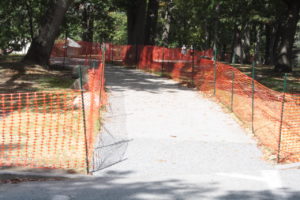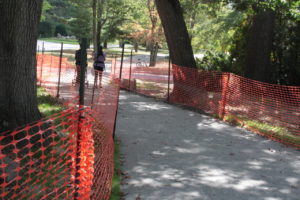 Until recently, want of a plan for repair that would hold up a long time in the face of intensifying storms and the cash to execute it has delayed work on the heavily compacted path. Starting in 2017, the Blackstone Parks Conservancy (BPC) and the Parks Department worked out a lasting solution and eventually found $75,000–enough for a key experimental section, but a drop in the bucket that could eventually require an estimated one million dollars to be raised from the city, grants, and individual donations.
Until recently, want of a plan for repair that would hold up a long time in the face of intensifying storms and the cash to execute it has delayed work on the heavily compacted path. Starting in 2017, the Blackstone Parks Conservancy (BPC) and the Parks Department worked out a lasting solution and eventually found $75,000–enough for a key experimental section, but a drop in the bucket that could eventually require an estimated one million dollars to be raised from the city, grants, and individual donations.
The money scraped together by local City Council representatives and the Parks Department is nonetheless a vital drop for it should provide reliable answers to how best to proceed with the rest of the popular 1.6-mile walkway worn by erosion and heavy use. Results will yield information about costs, proper engineering, and what surfaces work best in what situations, in addition to giving valuable feedback from the public–the users, who are, after all, what this is all about.
Painstakingly prepared by landscape architect and BPC board member, RISD professor Colgate Searle, who drilled dozens of holes along the way to find out what kind of material lay underneath, the plan divides the path into four types needing different approaches. Some involve digging out non-porous soil and installing gravel for drainage, others need less work.
 For the experiment, the Parks-BPC team chose a challenging section with particularly severe erosion and vulnerable tree roots north of the Trolley Shelter. On top of six to eight inches of fresh gravel, an expensive new surfacing material that allows absorption of some water while stabilizing the path is being applied to the steep section, stonedust to the flatter part. Some boulevard users will remember that the new material was tried out on a thirty-foot section recently to generally positive notices.
For the experiment, the Parks-BPC team chose a challenging section with particularly severe erosion and vulnerable tree roots north of the Trolley Shelter. On top of six to eight inches of fresh gravel, an expensive new surfacing material that allows absorption of some water while stabilizing the path is being applied to the steep section, stonedust to the flatter part. Some boulevard users will remember that the new material was tried out on a thirty-foot section recently to generally positive notices.
Meanwhile, walkers are being routed to a temporary path that will require repair later, particularly aerating and seeding once it is no longer needed. Searle is particularly concerned that new grass on the edges of the path, which is being brought back to its original width of ten feet in places, be protected. The project is scheduled for completion in mid-September.
“It’s a learning experience for all of us,” says Searle. Yes. And we hope it offers an enduring solution.
Jane Peterson
Update: As of September 30th, the newly resurfaced stretch of the path is open to the public, while the while the edges, newly seeded, are protected.



